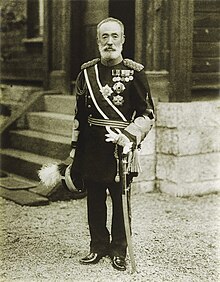Nogi Maresuke | |
|---|---|
乃木 希典 | |
 Nogi standing before his house in Nogizaka, Tokyo, shortly before his suicide in 1912 | |
| Governor General of Taiwan | |
| In office 14 October 1896 – 26 February 1898 | |
| Monarch | Meiji |
| Preceded by | Katsura Tarō |
| Succeeded by | Kodama Gentarō |
| Personal details | |
| Born | December 25, 1849 Edo, Japan |
| Died | September 13, 1912 (aged 62) Tokyo, Japan |
| Awards |
|
| Nickname(s) | Kiten Count Nogi |
| Military service | |
| Allegiance | |
| Branch/service | |
| Years of service | 1871–1908 |
| Rank | |
| Battles/wars | |
Count Nogi Maresuke (乃木 希典), also known as Kiten, Count Nogi GCB (December 25, 1849 – September 13, 1912), was a Japanese general in the Imperial Japanese Army and a governor-general of Taiwan. He was one of the commanders during the 1894 capture of Port Arthur from China and a prominent figure in the Russo-Japanese War of 1904–05, as commander of the forces which captured Port Arthur from the Russians.
He was a national hero in Imperial Japan as a model of feudal loyalty and self-sacrifice, ultimately to the point of suicide. In the Satsuma Rebellion, he lost a banner of the emperor in battle, for which he tried to atone with suicidal bravery in order to recapture it, until ordered to stop. In the Russo-Japanese War, he captured Port Arthur but he felt that he had lost too many of his soldiers, so requested permission to commit suicide, which the emperor refused. These two events, as well as his desire not to outlive his master, motivated his suicide on the day of the funeral of the Emperor Meiji. His example brought attention to the concept of bushido and the controversial samurai practice of junshi (following the lord in death).[1]
- ^ Benesch, Oleg. (2014). Inventing the Way of the Samurai, p. 153.